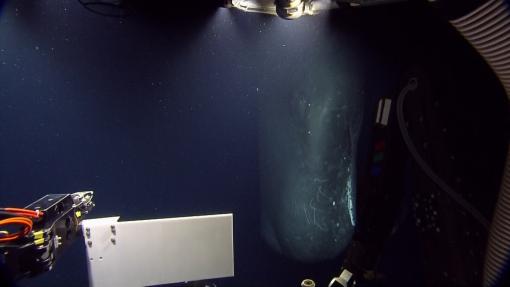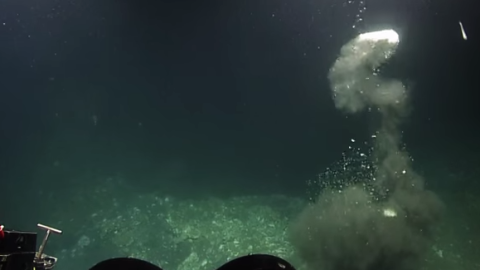Sperm Whale Encounter: Experts Answer Your Questions

Here are the answers to the most frequently asked questions about our recent encounter with a sperm whale in the Gulf of Mexico.
The responses below are a combination of feedback from Dr. Stephanie Watwood, Biologist at NUWC Newport who focuses on marine mammal social behavior and acoustic communication, and Dr. Shane Gero, Research Fellow at the Marine Bioacoustics Lab at Aarhus University in Denmark who works extensively with sperm whales.
Is the whale male or female?
This has been a challenging question to answer! General consensus among the experts who have examined the video is that it is a male, though the video of the underside of the whale is grainy so it is difficult to know with 100% certainty.
How big was the whale? Is it a juvenile or an adult?
It was difficult to tell the actual size of the whale, but the ROV Hercules is 6 feet wide in the front. Using this as a guide, and how close he was to the vehicle, it is estimated the whale was between 35-40 feet in length.
According to biologists we've consulted, the animal on the video is likely a juvenile, especially if it's a male. The sperm whale is the largest toothed whale. Adult males reach 16-20 meters (50-65 feet) in length, although most are less than 18 meters (60 ft). Females are much smaller than males, reaching only 11 meters (36 feet) on average.
How was the whale able to get so close to the ROV Hercules without knocking into it? Is the behavior that the whale exhibited common?
Sperm whales are surprisingly dexterous for their torpedo shaped body! Sperm whales in Alaska have learned to remove fish from long-line fishing nets with their mouths without becoming entangled themselves. Socially, sperm whales also rub their bodies against one another, and appear reasonably gentle when doing so. Just like all other marine species it has very fine swimming ability and good control over its buoyancy. Scientists have encountered a lot of curious whales who examine different objects or animals in their environment – even at the surface – a stray palette or bucket floating in the water or even a sea turtle taking a breath.
What might have caused the scarring we saw on the whale? Can individual whales be identified by their scars?
It could be a number of things, including squid tentacles and suckers, especially the scars around the efface and mouth; but likely not propeller scars like the comments made in the video. It could also be from other sperm whales. They often jaw each other when playing or socializing. Sperm whales are identified with the scars on the trailing edge of their tails.
Individual sperm whales are often identified by the coloration, scars, and nicks along their flukes. Sperm whales raise their flukes out of the water as they dive, and therefore this a reliable part of the body to use for identification purposes. Unique scarring along the body is also used for identification. Scaring may be from squid (both suckers and beaks have been known to leave scars) or from the teeth of other sperm whales (especially in males). Scientists in many areas maintain photo-ID catalogs, since comparing photographs of whales in different locations is a non-invasive way to track movements of individuals, and help determine if whales are resident or move between different areas.
What would have caused the whale to be curious and investigate the ROV?
The sperm whale's life is based on sound. It finds food and navigates using sound and it communicates and stays in touch with its family using sound. Sperm whales rely on their hearing to detect echoes from echolocation clicks that they emit for searching for prey. They therefore are believed to have very good hearing, although actual hearing has not been tested in a sperm whale. The clicks sperm whales produce have energy up to 15 kilohertz, but the peak frequencies are generally less than 3 kilohertz (people at birth can hear 20 Hertz to 20 kilohertz [20,000 Hertz]). It is also possible that lights on the ROV Hercules were attractive, as most light at those depths comes from bioluminescence. Sperm whales are thought to have good vision based on eye anatomy and their eyes appear to show good sensitivity to light. It may have been attracted to the lights which are atypical for that deep.
Why was the whale alone or was there more nearby? Are they typically loners?
A lot like elephants, sperm whale society is matrilineal. Grandmothers mothers and their daughters living together for life. The females will live in their natal units for life, but the males will leave their families in their early teens. If it was an adult male, they live their lives mostly alone and come to warmer waters to rove between units of females breeding. However if it was a juvenile male and still living with his mother, it’s likely that other animals would be nearby. Group size in the Gulf of Mexico is similar to here in Dominica and is around 7 animals. And they spread out when foraging at depth.
The animal may have been alone because it was in the middle of a deep dive. Animals will often separate while diving, and then regroup at the surface in between dives. Sperm whales in the Gulf of Mexico spend about 70% of their time performing deep foraging dives. Each dive lasts about 45 minutes, and then they will rest about 8 minutes before starting the next dive. They often dive to the sea floor, and sperm whales in the Gulf of Mexico have been shown to dive 500-800 meters. They spend about 30 minutes at the deepest depths actively searching for prey. Sperm whales use echolocation to search for and detect prey, and scientists use tags attached to sperm whales that record their vocalizations to determine when whales were feeding during dives.
Are this type of whale common in the Gulf of Mexico? What are their migration routes?
There is a population of sperm whales that lives in the Gulf of Mexico, and scientists think the units of females rarely leave. The most recent abundance estimate by the U.S. National Marine Fisheries Service for the Northern Gulf of Mexico is 763 animals, based on ship surveys from 2009. Sperm whales do not migrate yearly like baleen whales. Female units range across areas that vary depending on geography. In the Caribbean homeranges are small, about 500km across, but movements of 2000km in the Pacific are common.
Sperm whales are found in all oceans of the world, and are usually found along continental slopes or canyon ridges. In general, females and their offspring are found in temperate and tropical waters. As males mature, they move towards the higher latitudes, eventually reaching the Arctic or Antarctic waters. The water is more productive at higher latitudes (meaning the water has more nutrients which leads to more prey species available), and males need to feed in these more productive waters to support their large body size. Mature males then migrate back to lower latitudes to mate.
What is the lifespan of this type of whale?
The sperm whale lifeline is similar to that of a human. Gestation is 15-18 months, sexual maturity is in their early teens, females reproduced every 4-6 years until their 40s or 50s when they stop breeding (we don’t know if there is a physiological menopause) and they can live to 70-90.
Are they endangered, or rare in the Gulf of Mexico?
Sperm whales are listed as an endangered species under the U.S. Endangered Species Act. Sperm whales area also listed as vulnerable by the International Union for the Conservation of Nature (ICUN). The global population size is estimated as somewhere between 100,000-300,000 animals.
Although they were heavily targeted by commercial whaling through the 1950s, entanglement in fish gear is the primary threat to sperm whales today. Sperm whales also are occasionally struck by ships or ingest marine debris, and they carry high levels of contaminants in their bodies, although it is unclear how that impacts their health.

GISR: Natural Gas Seeps in Gulf of Mexico
What impact do natural hydrocarbon seeps have on the ocean and atmosphere? This is one of the key questions we’ll be investigating on this leg of the expedition. This expedition is part of the Gulf Integrated Spill Response (GISR) Consortium, funded by the Gulf of Mexico Research Initiative (GoMRI). The vision of the GISR Consortium is to understand and predict the fundamental behavior of petroleum fluids in the ocean environment.



